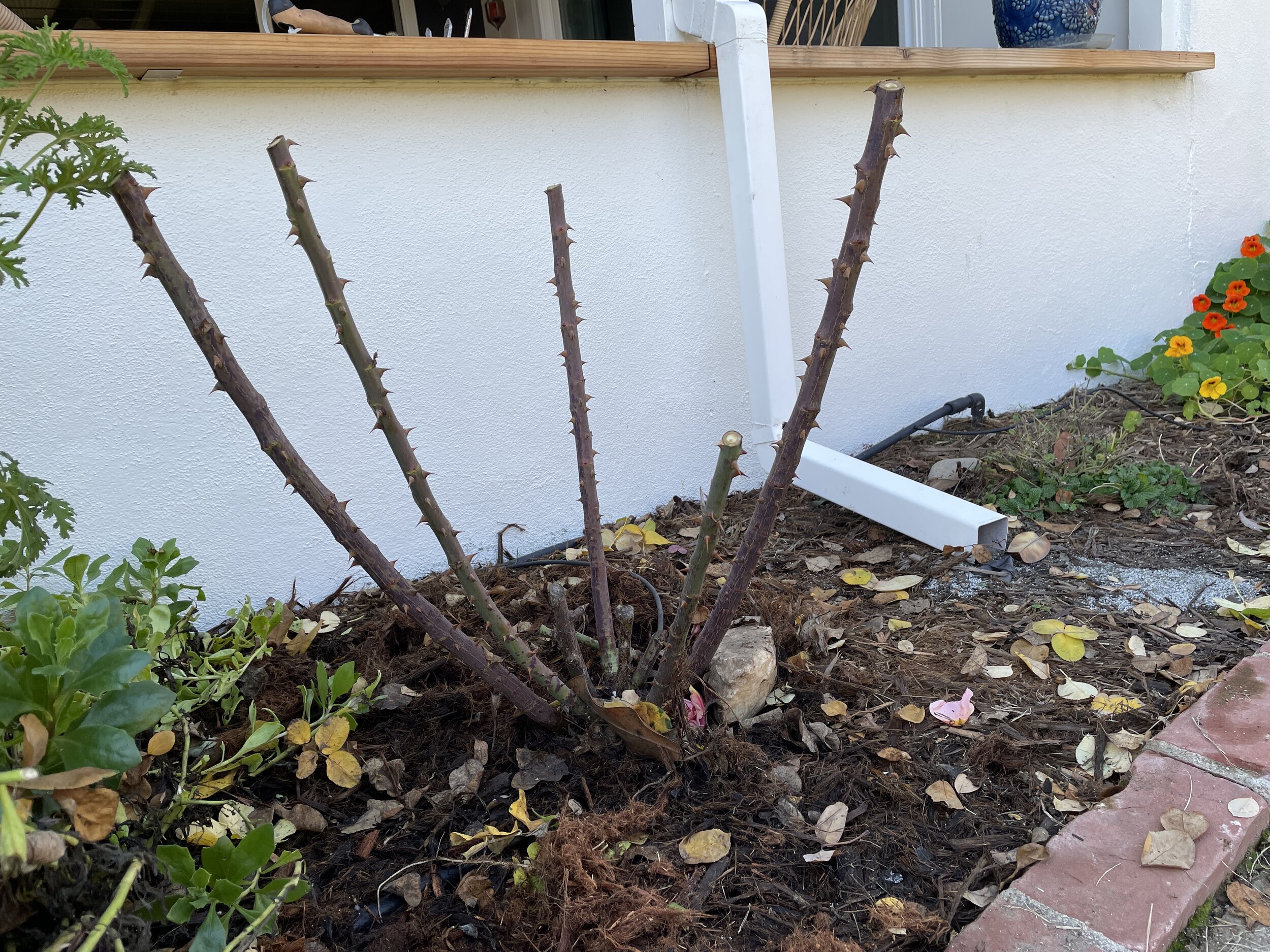Pruning Roses in Winter
This post does contain affiliate links. By clicking the link and making a purchase we receive a small commission at no additional cost to you! This helps us keep the lights on and continue to bring you great content.
Roses are a delight to grow and seeing those beautiful blooms all summer long puts a smile on everyone’s face. If you are new to gardening or new to roses, these plants may be intimidating. But don’t fret, caring for roses is easy and takes just a little bit of work throughout the year. By taking the time to care for your rose, you are encouraging overall plant health and guaranteeing the best blooms all summer long - and who doesn’t want that?
At Our Liberty House we have two varieties of roses - two Hybrid Tea Roses and two Climbing Roses. In this article we are going to explain the benefits of pruning, when you should prune and how to do it correctly. If you’d like to jump straight to either topic, click on the links above!
First things first, each rose variety has different needs. If you aren’t sure what kind of rose you have you will first want to identify it! We love using Google Images (free app on your phone) where you can ‘reverse Google Image Search’ the plant (typically take a picture of the leaves or blooms) and it produces a Google search of various similar roses. Though it is not 100%, we find it usually pretty accurate.
A reminder that in this article we will specifically be talking about our Hybrid Tea and climbing roses. Though pruning across varieties is similar, prune to your variety.
In general, roses need air around their base. The winter prune is the best time to make sure you open up that center and make sure your rose will get plenty of airflow. If you struggle with powdery mildew or other diseases during the summer months this is especially true. When choosing the stems to keep versus take out, make sure to pick ones that are outward facing and not too close together.
A general rule of thumb when pruning is to cut back any stems that are green and less than a pencil in diameter, leaving the stems that are woody and thicker in diameter.
Roses also tend to grow into itself during the growing months. Winter pruning is a great time to get rid of any stems that overlap or cross each other. This will prevent rubbing and reduce your chances of allowing disease or harmful bacteria to enter your rose.
Q&A: Be sure to leave us a comment or reach out on social media if you have any additional questions not answered here!
What do I need to have before I prune:
Sharp shears, gloves and long sleeves.
When is the best time to prune roses?
This is based on your rose variety and zone. Generally, you want to prune in the early spring before the last frost date. This encourages your plant to go into dormancy, focus on root production, and be set up to focus on step and bloom production the following spring and summer.
Why do I need to prune my rose?
Pruning allows your rose to take a break! In our zone (9b) our roses will still be trying to bloom through winter but we want to force them in to a dormant stage to reset. Pruning also allows us to change the shape or structure of our rose bushes and encourage them to grow in a shape that fits our space.
Should I compost my rose clippings?
Yes and no - you just want to be mindful of introducing any disease into your compost bin. If you ‘hot compost’ and are able to maintain a composting temperature between 150-160 degrees Fahrenheit, it won’t matter so much as this will typically kill any lingering bad bacteria. If you cold compost, or aren’t sure what temp your compost bin is, we recommend throwing all the rose leaves into your yard waste bin for city disposal and composting the stems. And from experience, we recommend shredding your rose stems so they compost faster. We use this electric chipper and it shreds rose stems like a pro.
Hybrid Tea Rose Pruning
The first step to pruning a rose is to defoliate the lower half to one-third of the plant. This allows you to really see what is going on with your plant and decide which stems to remove and which to keep.
Identify an outward facing bud on your rose, and prune above
For best results, you will want to remove all but 4-5 main stems. To help narrow it down, remove any damaged or crossing stems. Stems that cross can rub each other causing damage to the plant and invite disease. Keep stems that are equally spread out from each other that will form a uniform and full rose bush.
Once you have selected the stems to keep you will want to cut them down to 12-24” in length. It is best practice to cut down to an outward facing bud. Cutting down to an outward facing bud will encourage the new growth to grow up and out. To note, the 12-24” is a guideline and varies slightly by region. Last year we cut our rose down to 30-36” (leaving it pretty tall) and our rose produced blooms early and also grew taller than our house. This year we cut it down to closer to 24” so it wouldn’t get as tall.
Although this can be intimidating for most new gardeners, it is really that easy and will set your next growing season up for success. Also, make sure you use this time to clean up the crown (the base) of the rose by removing any leaves or other dead fall.
Hybrid Tea Rose pruned before spring
Climbing Rose Pruning
Climbing rose pruned for winter
Pruning a climbing roses accomplishes the same goal of forcing your plant in to dormancy and also reshaping for future growth but with a small change in strategy.
Climbing roses usually are trained to cover some sort of structure which you don’t want them to have to re-do this every year. Therefore, you only defoliate (remove the leaves) and thin out our climbing roses. If you make the mistake of pruning them down completely (to 18-24” like a standard rose), you won’t kill the rose, but you may notice far less blooms the following year. By only defoliating (and not cutting completely back), will help the plant focus on blooming the following year, rather than regrowing it's stems.
To prune your climbing rose, first begin by completely removing all the leaves. Just like the Hybrid Tea Rose, you will want to cut back the excess stems leaving only 3-4 of the thickest stems. Before cutting be sure to identify any crossing stems and remove at least one (unless you can carefully separate them) as these will rub over the season, cause tears in the stems and invite disease in.
This is also a great time to carefully train your climbing rose. For us, we make sure that the three remaining stems are separated on the trellis and also winded through the top of the trellis. If you do not want your rose to grow any taller, you can snip the top of the stem to prevent further growth in that direction.
If you enjoyed this article you may also be interested in these!
DIY Rose Water + Ways to Use It!
Homemade Rose Petal Jam Recipe
The 4 Best Resources for Beginner Vegetable Gardeners in 2021
2 Easy Ways to Attract Bees to your Yard
Thanks for reading! Be sure to say hello to us on Facebook, Instagram and YouTube!
Happy Growing,
Beth & Lucas





